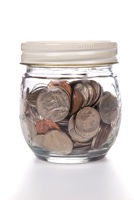Posted on October 14, 2021

It’s a question you might have never thought to ask: why are coins round? Round coins have been a part of commerce for centuries, but did you know that this decision was about more than just aesthetics? Let’s travel back to ancient times to understand better how our coinage got to be the shape it is today.
 Metalworkers produced ancient coins through a hammering process that engraved markings onto the surface of the coin. This process may have even begun as early as 600 BC. Two dies were used — an upper die and a lower die — which were carved with the markings or images that the coin maker wished to engrave. In between the dies, they placed a blank (a plain piece of metal). The metalworker would then strike the upper die. When struck, the force causes the blank to be engraved with markings from both dies. When struck with a hammer, the coin naturally formed into a roundish shape.
Metalworkers produced ancient coins through a hammering process that engraved markings onto the surface of the coin. This process may have even begun as early as 600 BC. Two dies were used — an upper die and a lower die — which were carved with the markings or images that the coin maker wished to engrave. In between the dies, they placed a blank (a plain piece of metal). The metalworker would then strike the upper die. When struck, the force causes the blank to be engraved with markings from both dies. When struck with a hammer, the coin naturally formed into a roundish shape.
In theory, ancient metalworkers could form dies in any shape, but it made sense that a circular shape was chosen. Round dies were easier to work with since they did not need aligned axes compared to dies of other shapes. Many of these first coins were of slightly uneven shapes due to irregularities in the manual striking process. Over time the coin production process was improved, and round coins became more and more uniform.
Coin shaving (or clipping) is a counterfeiting measure where a counterfeiter removes small amounts of metal from a coin and collects them, to melt down and sell as scrap. Coin shaving was a considerable problem when coins were made of precious metals like gold and silver.
Coin shapes that contain edges make them more vulnerable to coin shaving because there is more edge surface to clip a coin. And mathematics backs this up. A circle has the lowest ratio of perimeter to the area, meaning it has less edge to shave. Therefore, coin clippers could not as easily remove metal from the coin’s edge, thereby reducing coin shaving risks. Round coins are made with reeded edges to prevent shaving and clipping.
 Gone are the days of hammer striking. Instead, mints use large machinery to mass-produce coins to increase efficiency and reduce costs. Before striking, a plaster model of the coin is made and used to create master dies, a more uniform process than in the old days. Blanks are made from metal sheets and fed through a blanking press that punches round-shaped discs used for the blanks. When they are ready to be pressed, blanks are fed through a coin press which can strike up to 720 coins per minute.
Gone are the days of hammer striking. Instead, mints use large machinery to mass-produce coins to increase efficiency and reduce costs. Before striking, a plaster model of the coin is made and used to create master dies, a more uniform process than in the old days. Blanks are made from metal sheets and fed through a blanking press that punches round-shaped discs used for the blanks. When they are ready to be pressed, blanks are fed through a coin press which can strike up to 720 coins per minute.
But in truth, there’s no real reason why coins retained their round shape today, as some of their perceived benefits — like a reduction in coin shaving — aren’t an issue in the modern world. Additionally, as technology has improved, it is seemingly just as easy to produce round coins in any other shape. Yet, round coins remain the pervasive shape of most coins throughout the world. After all, it’s challenging to change habits and traditions once they are ingrained into society.
While today’s coins are most commonly round, there are still plenty of other shapes for coinage used throughout the modern world. Here are just a few types of different coin shapes and some examples.
|
Shape |
What is it? |
Example |
|
Triangular |
3-sided coin with rounded corners |
Cook Islands two dollar coin |
|
Rectangular |
4-sided coin |
St Helena 10 oz £10 coin |
|
Octagonal |
8-sided |
Singapore one dollar coin |
|
Nonagonal |
9-sided |
Philippines five peso coin |
|
|
10-sided |
Chile fifty pesos coin |
|
Dodecagonal |
12-sided |
British one pound coin |
|
Holed |
Circular coin with a hole in the center (historically used for stringing a number of coins together) |
Japanese five yen coin |
|
Scalloped |
Wavy edges around the entire coin |
Hong Kong twenty-cent coin |
|
Unique shapes (rarely intended for circulation) |
Varies, mainly collectibles |
Palau lucky horseshoe $5 coin, Solomon Islands lion-shaped $2 coin |